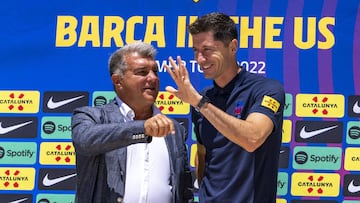What are Barcelona’s economic “levers” and how do they work?
Joan Laporta has activated the club’s emergency mechanisms to manage crippling debt of over €1bn and allow signings to be made.

Over the past few weeks Barcelona’s now famous economic “levers” have been activated to rescue the club from its paralyzing debt and allow it to do business in the summer transfer window, which has already seen the arrival of Robert Lewandowski for an initial €45m and Raphinha for €58m, against a balance of sales of just €23m (€20m for Philippe Coutinho and a €3m loan fee for Francisco Trincão). Among the keener mathematicians keeping an eye on Barça’s transfer dealings, this has obviously raised eyebrows. The club has reported debts of well over €1 billion and has been slashing the wage bill to make ends meet, and yet also splashed €55m on Ferran Torres in January. Just how is Barça juggling the books to strengthen Xavi’s squad? These economic “levers” hold the key.
The latest lever to be pulled by Joan Laporta to keep the club’s economy afloat was the sale of a percentage of the club’s television rights. Barcelona sold a further 15% stake in their LaLiga TV rights, in a 25-year-deal, to US private equity group Sixth Street, the club announced on Friday. The Financial Times reported the investment is worth more than €300 million, which has served to cleanse the Camp Nou’s accounts to the extent they are almost in the black for the season.
But what are Barcelona’s economic levers, how many are there and how exactly do they work? When talking about economic levers, we are referring to the mechanisms that the club has activated to clean up debt that would have otherwise prevented it from making any signings in the transfer market beyond loan deals and free transfers.
Barcelona’s economic levers are partial sales of assets via which the club obtains money immediately, serving to improve the condition of the Camp Nou’s battered accounts.
At the moment there are two primary levers: those related to merchandising and television rights. The first lever is BLM, the company that manages the club’s official merchandise, such as shirts, mugs, pens, scarves, etc. The sale of 49.9% of BLM was approved at the recent Barcelona club assembly in a deal worth in the region of €200m.
The second is television rights. In the assembly it was agreed that the club would only seek deals worth a maximum of 25% of their overall rights. Barça sold 10% of those rights to Sixth Street in June in a deal worth €267m, of which the US firm will invest €207m back into the club. But the income is not direct and cannot be lavished on new players.
How do Barcelona’s levers work?
What is received from each lever is not direct income, according to Spanish broadcaster Cadena SER. Of the money Barça will generate, 15 percent goes toward increasing the salary limit (player wages accounted for 103% of total income when Laporta took over the club in March 2021, when total debt stood at €1.35bn), 70 percent to improve infrastructure and the remaining 15 percent to service the club’s debt. Even so, Barça’s ability to meet Liga restrictions on salary caps is still not guaranteed, despite having been reduced by €144m already.
Barcelona also signed a €236m sponsorship deal with music streaming service Spotify earlier this year.





